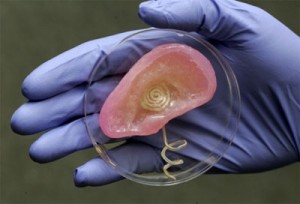
The technology involves using a three-dimensional “pattern” to guide a computer in laying down layers of materials in a process they have dubbed “additive manufacturing.” The expected uses range from the creation of small toys, jewelry, makeup and edible goods to body replacement parts and large-scale manufacturing of a host of items. To date, patents have been issued for 45 different materials intended for use in 3D printing, including ceramics, clay, palladium, paper, rubber, silver, titanium and wax.
The myriad anticipated uses are just coming into being. Likely to be in general use first are these applications:
Medical: Researchers already are using 3D printers to do bioprinting – creating of tiny strips of organ tissue and facial appendages including ears and noses. The predictions envision printed organs such as kidneys and livers. Initially, these printed organs will likely be used for testing drugs and vaccines. Ultimately, they could fill the huge gaps in the availability of viable human organs and the numbers of patients who need them.
Pete Basiliere, a leading analyst of 3D printing potential, predicts that the advances in organ printing will outpace the public’s understanding and acceptance of the technology. 3D organ printing, he assumes, will join similar medical advances, such as organ transplantation and use of stem cells to treat patients, in a learning curve before the public adopts the idea. The same ethical questions that have been raised about artificial hearts and other cutting-edge technologies are likely to be debated: Are humans trying to play God? Are new medical innovations creating “rich men’s remedies” that will exclude the poor? If the past is an indicator, the life-saving benefits of the new technologies will triumph, Basiliere expects.
Another potential medical use is creation of prosthetic limbs. A 13-year-old girl who lost an arm in a boating accident was fitted by students at Washington University with a 3D-created prosthesis that used about $200 worth of materials, a stark contrast to the $6,000 cost of similar devices created by current processes. Another girl from Illinois, who was born without fingers, was fitted with an operating set of plastic fingers at a cost of $5. A high school engineering class created the prosthesis. In Canada, researchers are working toward 3D printing processes to create prosthetic limbs for victims of civil war injuries in Uganda.
The fashion industry dressed models in outfits created by 3D in the New York Fashion Week shows in 2013. Such eminent performers as Lady Gaga have garbed themselves in 3D dresses. She wore the world’s first “flying dress” to the 20133 ArtRave. The world’s first 3D printed bikini, the N12, is named for the material a computer used to create it: Nylon 12.
Some organizations devoted to the war on global poverty see the potential for such things as solving water hygiene problems in Third World countries. They envision needy people using “mini factories” to create products that would provide them a living. 3D may provide simple answers to such pervasive problems as hand sanitation in refugee camps.
There’s a good chance that one of your next automobiles will be created through 3D printing. A prototype, the Urbee, has been designed by Kor Ecologic. The two-seater gets up to 200 miles per gallon of fuel. Estimated cost: about $20,000.
Personal 3D printers are likely to join the standard electronic equipment in the vast majority of American homes. At present, they’re generally expensive and hard to operate. Some require hand assembly. However, there is little doubt in the minds of those who know about such things that the problems will be resolved and that affordable 3D will be available. But there’s a long road ahead until such technology finds its logical and practical uses for most Americans.